More Signs of Low FCC Throughput on Spectrum Policy
The Commission has broad general power to delegate issues to its staff subject to oversight and review but the specific delegations listed in Part 0, Subpart B of the Commission's Rules probably haven't been updated in decades. Under the previous chairman there were accusations that existing delegations were abused to deprive the other commissioners, especially those of the minority party, of their "right to vote". Note that these accusation did not deal with any matters even vaguely related to the example in the TPRC paper above. We have urged a complete and thorough review of delegations along with better guidance from the Commission for the staff on general policies for handling technical spectrum policy issues that are uncontroversial.
In the previous blog post here we discussed 2 bad signs of slowness and resource limits in spectrum policy. Here are some more:
- On the agenda for the May 2017 commission meeting is an item identified as "Part 95 Reform". This is a report and order in Docket 10-119. Didn't that begin in 2010 judging from the Docket number? A quick review of EDOCS gives the result below:
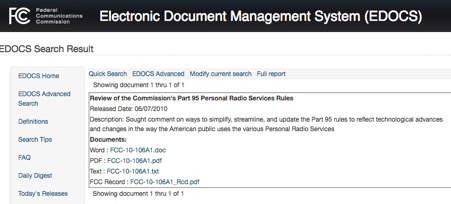
There has been no FCC activity in this docket since the NPRM was adopted almost 7 years ago! A review of the comment files show some recent ex parte meetings but not a lot of controversy. Where has this rulemaking been for the past 7 years? We suspect that the 8th Floor and the WTB top leadership are so focused in net neutrality and 5G issues that other issues just get ignored. This is consistent with a contact I had with a WTB middle manager on how they might proceed with a new spectrum issue related to drones that a potential client was interested in. The middle manager said that the WTB front office had little or no interest in ANY issue that was not cellular! So the drone spectrum policy issue would probably just linger without action as all drone spectrum issues have to date.
- Another issue moving at glacial pace is Docket 13-39, an update of the FCC's RF safety rules. This is both more controversial and more significant. While traveling recently I had dinner with a fellow FCC retiree. He recently wrote me about this rulemaking saying "I started working on that project in 2003, 14 years ago!! It may outlive me!" While this rulemaking has some controversy, as indicated in our comments in the vital Wireless Infrastructure rulemaking, Docket 17-79, it is a key factor to facilitate the rapid implementation of new infrastructure. A recurring problem with local governments is whether new cell sites are safe. Pointing to rules adopted decades ago without much real updating is not very credible. So why can't FCC resolve it in time? The pending downsizing of EPA could have a real impact here since FCC and EPA share jurisdiction in this area and EPA has provided technical support on proper safety limits and how to measure them. After EPA is downsized, this rulemaking will become more difficult!
So we urge the FCC top leadership to review the overall throughput issue of FCC on spectrum policy issue and consider delegating more issues the commissioners are not personally interested in to the staff subject to policy guidelines and safeguards. This is what Ofcom does and while Ofcom's guidelines to its staff are not public, I suspect the FCC commissioners could ask Ofcom for a better understanding of how they manage their process and a few examples of guidelines for staff action.
The current FCC spectrum policy throughput problem was not created by the current chairman or his predecessor, but has built up over a decade or two. It is now time to start solving it, especially since Chmn. Pai is committed to Section 7 compliance for the first time.
Cellular Industry:
Time to Take Ownership of Part of the Wireless Infrastructure Poblem

The Commission will consider a Notice of Proposed Rulemaking and Notice of Inquiry that commences an examination of the regulatory impediments to wireless network infrastructure investment and deployment, and how the Commission may remove or reduce such impediments consistent with the law and the public interest. (WT Docket 17-79; WT Docket 15-180)
Delays in infrastructure are a major issue in spectrum policy because in reality MOST growth of wireless capacity comes from new infrastructure; the contributions of new technology and new spectrum are minor by comparison - even though both are also needed. But the FCC draft never addresses a basic issue: Why are local government slow in approving new wireless infrastructure?
Let me posit two basic reasons:
- Wireless infrastructure is often needlessly ugly and often designed with little regard for the environment around it.
- Lack of confidence in FCC's RF safety policies and resulting safety fears.

I
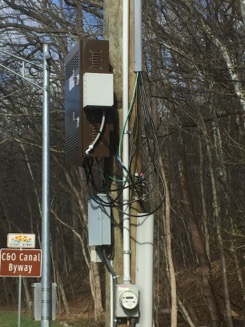
Should the industry have a public strategy on the aesthetics of new 5G infrastructure other than vague talk about "pizza boxes" and pictures of them held by a spokesman, not in actual installations? The proposed Mexican border wall will be generally in remote rural locations but the presolicitation published by DHS clearly states:
"Detailed requirements will be included in the RFP, but for planning we anticipate procuring concrete wall structures, nominally 30 feet tall, that will meet requirements for aesthetics, anti-climbing, and resistance to tampering or damage." (Emphasis added)
While the federal government shouldn't determine aesthetics goals for 5G, shouldn't the industry at least have publicly stated goal for this new ubiquitous addition to our urban design?
Should the public be able to see how well the industry is meeting the goal it sets?
My FCC filing does not oppose any aspect of the draft NPRM the FCC will vote on soon. It does point out that without attention to the two likely root causes of the local government delays this proceeding, like many other before it, will fail to meet its goals.
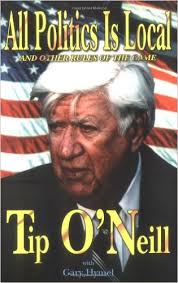
"All politics is local".
Placing ugly infrastructure on every block in America and preempting local jurisdiction in order to do this could be a good test of whether Tip's famous phrase is still true. Will it result in a major grassroots backlash if implemented as currently structured? Time will tell! Wouldn't it be better (and even more Republican) to defuse part of the problem with non regulatory approaches?
But wouldn't a better approach include voluntary action from the cellular industry with FCC encouragement to pay more attention to the physical design of its infrastructure and its compatibility with its neighbors? While in a few cases there may a need for very expensive custom designs, more attention to design basics like covering or grouping caring and use of paint to minimize the visual impact of equipment will not be major cost factors. However it will need management attention.
As mentioned at the beginning, RF safety concerns are also a factor in local resistance to wireless infrastructure. While I don't think these concerns are valid, the fact that the basic FCC RF safety rules are decades old and that the most recent rulemaking on the topic, Dockets 03-137 and 13-84, have been stalled for years shows apparent FCC apathy on the topic. FCC's partner with shared jurisdiction on RF safety is EPA and the pending severe budget cuts at that agency will make it even more difficult to update RF safety rules to keep them credible. FCC worked closely with the cellular industry to move the Spectrum Frontiers/5G docket at record pace. Both should realize that updated and credible RF safety rules are important to maintaining public confidence in wireless infrastructure - especially as it starts reaching even block in America!
FCC Dismisses Complaint Related to OETB65C RF Safety Issue

On December 20, 2012 FCC, in the above action, dismissed a complaint by Ms. Cynthia Franklin under the obscure provisions of the Data Quality Act (“DQA”) - a 2001 piece of legislation your blogger had never heard of before.
Before getting into the details of Ms. Franklin’s complaint, let me point out that document is a reminder of a more general problem of the FCC website even after there recent improvements: Despite the huge amounts of (poorly organized) data on the FCC website, this complaint and the supporting document are nowhere to be found because it is a “undocketed” proceeding that also lacks any file number. Thus its very existence was unknown to the public until the 12/21 date of the above Order. Indeed even now there is no obvious way to see the whole text of the complaint short of filing a FOIA request and having FCC staff then quibble over whether they should charge you to see this information. Is this really “a government worthy of its people”?
(I also note that as of the drafting of this post, a search of the FCC website on “Cynthia Franklin” yields no results at all!)
OETB65C
Back to the specific issue of Ms. Franklin’s complaint, this deals with an issue that has been discussed here repeatedly since November 2010: OET Bulletin 65, Supplement C (“OETB65C”). This document has as a title, “Evaluating Compliance with FCC Guidelines for Human Exposure to Radiofrequency Electromagnetic Fields Additional Information for Evaluating Compliance of Mobile and Portable Devices with FCC Limits for Human Exposure to Radiofrequency Emissions”. This document describes its function as:
The purpose of this revised supplement is to provide parties filing applications for equipment authorization with guidance on complying with the latest requirements using up-to-date test procedures. This supplement is not intended, however, to establish mandatory procedures, and other methods and procedures may be acceptable if based on sound engineering practice.
Thus it is not a “regulation” because it is not “mandatory”, but it does give a “safe harbor” showing equipment authorization applications what FCC will accept for compliance showing with RF safety issues. As Time Magazine pointed out in 2010,
FCC testing regulations notably chose not to simulate a situation in which the phone was broadcasting at full power while inside a shirt or pants pocket flush against the body, an odd oversight given the known habits of many cellular-phone users.
OETB65C was issued in June 2001 and lists 2 authors and 3 contributors. (Only one of these people still work at FCC and I suspect he had little involvement with the controversy at hand.) Your blogger worked in OET management at the time and had absolutely no involvement. Indeed, OET was under acting leadership in the early Powell chairmanship at that time as Ed Thomas did not arrive as its chief until early 2002. As quoted in the FCC Order (remember, the actual compliant is still not on the public record due to the website problems mentioned above), the Franklin complaint deals “three of the FCC consumer documents” arguing that “the documents should be corrected to state that cell phones are not tested for RF exposure during use in direct contact with the body, and therefore they should not be used in such a manner.”
The December 20 Order reaffirms OET’s October 2011 rejection of the Ms. Franklin’s compliant - a document also not on the public record. The grounds seem to be a narrow interpretation of the Data Quality Act. Perhaps thee grounds are even a correct interpretation of the Data Quality Act.
Here is a sample of the FCC’s logic:
Ms. Franklin’s concerns, however, misconstrue the purpose of the document at issue, which is not to provide advice on how best to hold and use a cell phone, or to allow consumers to critique the sufficiency of testing methods, but rather to explain why a single reported maximum SAR value is an insufficient basis for comparing the likely RF exposure from individual cell phone models. Indeed, the guide emphasizes that SAR testing “does not indicate the amount of RF exposure consumers experience during normal use of the device.” And while Ms. Franklin asserts that the guide will encourage consumers to carry cell phones against their bodies, the only statement in the guide about how to carry a phone is quite to the contrary, noting that “the most effective means to reduce [RF] exposure are to hold the cell phone away from the head or body and to use a speakerphone or hands-free accessory.”
So basically the document at issue is not guidance to consumers, so it doesn’t matter if it is misleading! It is just guidance to cell phone manufacturers on how to avoid the intention of the FCC’s RF safety rules and there is no Data Quality Act issue involved in that under FCC’s logic.
Cell phone industry: If you want to gain the trust of the US public on RF safety issue you should not hide behind such charades. While your blogger believes that cell phones as actually used these days are safe, the sordid history of OETB65C does not reflect well on the cell phone industry and FCC’s objectivity on safety issues. Better transparency is needed in the drafting and implementation of FCC Rules on RF safety to keep the public trust.
9th Circuit Court of Appeals Hears CTIA vs. SF Cell Phone Disclosure Case:"Must See TV"
Video of oral arguments
Your blogger surprised the CTIA legal team on Thursday by showing up at the Federal Courthouse in San Francisco to hear the oral arguments before the 9th Circuit of Appeals on the litigation captioned CTIA - The Wireless Association v. The City & County of S.F. as well as a countersuit. (Actually I was in San Francisco on an unrelated technical matter and had free time in the morning and the oral argument seemed the best free show in town.) The case was argued before Judges Schoeder, Callahan, and Korman by CTIA’s Andrew McBride of Wiley Rein and Deputy City Attorney Vince Chhabria represented San Francisco.
If you are interested in the pleadings, CTIA has posted one recent pleading. The other side has 2 pleadings available on their website: San Francisco's opening 9th Circuit brief (Jan. 25, 2012);Francisco's opening 9th Circuit brief (April 4, 2012) Complete pleadings of all parties are available on the court’s PACER system but registration is needed and fees must be paid if you download more than 150 pages/quarter. (If you use PACER, the case numbers are Nos. 11-17707, 11-17773 ). I will post links to more pleadings if the parties supply them.
On the eve of the oral arguments, GAO released a new report on the cell phone health issue. The SF City Attorney then used this for a press release:
Just two days before a key federal appeals court hearing was set to get under way in the mobile phone lobby's legal challenge to San Francisco's cell phone consumer information ordinance, the U.S. Government Accountability Office released a report expressing concern that the Federal Communications Commission has failed to keep up with scientific developments on the possible link between cell phone radiation and cancer. The report by the GAO -- the independent, nonpartisan auditing agency that works for Congress -- was commissioned a year ago to review FCC standards after a panel of 31 leading scientists from the World Health Organization concluded that the radiofrequency energy exposure from cell phones is "possibly carcinogenic." The report is titled, "Exposure and Testing Requirements for Mobile Phones Should be Reassessed."
At issue is a fact sheet that has been revised by the first judge to hear the case (available here at p. 68) and now includes the following statements:
The pending SF fact sheet is amazingly similar to a brochure that comes with all French cell phones and SIM cards as was discussed previously here. The brochure comes from FFT, the French counterpart of CTIA, and the content is shown on their website. Lest you think FFT is a wimp compared to CTIA in defending cellular interests on this issue, here is a recent letter from FFT to France Télévisions, the French counterpart of BBC, complaining about a TV documentary program on the RF safety issue."Although all cell phones sold in the United States must comply with radio-frequency safety limits set by the Federal Communications Commission, no safety study has ever ruled out the possibility of human harm from RF exposure.
"RF energy has been classified by the World Health Organization as a possible carcinogen (rather than as a known carcinogen or a probable carcinogen) and studies continue to assess the potential health effects of cell phones"
CNET.com wrote that McBride said San Francisco's attempt at educating the public about cell phone radiation was "laughable”. CNET went on to write “Chhabria pointed to California's Prop. 65, which requires the state to publish a list of chemicals known to cause cancer or birth defects or other reproductive harm. Businesses must label products or post warnings if a businesses knows or thinks that a listed chemical has been used.” The discussion between distinguished counsels and the 3 judge panel went on to discuss mandated Prop. 65 warning in Starbuck’s in California. I believe 2 of the 3 judges had never seen this warning and it is clear it was not affecting their coffee drinking habits.

“Chemicals known to the State of California to cause cancer and reproductive toxicity, including acrylamide, are present in coffee, baked goods, and other foods or beverages sold here. Acrylamide is not added to our products, but resulted from cooking, such as when coffee beans are roasted or baked goods are baked. As a result, acrylamide is present in our brewed coffee, including coffee made at home or elsewhere from our beans, ground, or instant coffee, baked goods or other foods sold here, in grocery stores or other locations.”
Mr. Chhabria pointed out that the language of Prop. 65 only applies to chemicals and thus does not apply to cell phones. However, he also pointed out that Pro. 65 requires such warnings for all chemicals identified by WHO as “possible carcinogens”, the same classification that cell phones are now in. Mr. McBride pointed out that if ink was a possible carcinogen, then all printed documents would have to be labeled under this concept. However, he did not address the point that WHO so classifies cell phones not ink.
Nevertheless there is not evidence that cell phones cause any pathology in their users and your blogger is puzzled by the “antis” and their focus on “malignant brain tumors”. If a pathology is ever proven, it could well be something entirely different! Or there could be no pathologies since there is not present understanding of how RF at typical levels could cause any pathology.
The James R. Browning U.S. Court of Appeals Building where the oral arguments were held was built in 1905 and reopened in 1910 after the 1906 earthquake. It is listed in the National Register of Historic Places. Here is a beautiful mosaic mural in the court room where the arguments were held.

WashPost "FCC considers whether to study cellphone radiation"

A”phantom” often used for SAR measurements.
Simulated cavity is filled with special liquid to simulate body’s electromagnetic qualities.
Probe is inserted in simulated head to measure electromagnetic fired resulting from cell phone emissions and focusing or diffusion by body shape and its physical parameters such as conductivity.
Cell phone tested is under body cavity and can’t be seen in this photo.
(FCC also permits computer calculations of SAR that consider body shape and parameters.)
Last night the Washington Post posted an article on its web site that appeared in today’s print edition with the above title. The Post’s Cecilia Kang wrote:
The Federal Communications Commission is seeking to study whether it needs better guidelines to protect people from cellphone radiation, a question it hasn’t posed in 15 years…
The debate is sure to draw heavy interest. The deep-pocketed wireless industry opposes changes to current federal rules. Health advocates have argued that the government has ignored safety concerns raised by some scientists.
Studies have been split on the matter. Some have indicated that cellphone use poses no risk to humans.
Ms. Kang points out correctly that the 5 commissioners must vote to start any reexamination, something a little in doubt due to the cellular industry’s likely opposition and the degree that the current commissioners have focused on meeting the cellular industry’s spectrum demands - virtually ignoring former “top dog”- the broadcasting industry - in the process.
Historically, though, FCC has never really picked an RF safety standard. Since FCC is not a health and safety agency it has always deferred to a troika of such agencies (Environmental Protection Agency, Occupational Safety and Health Administration, and National Institute of Occupational Safety and Health) to recommend specific protection standards for the public and for occupational workers. FCC has consistently used standards that were proposed by the 3 agencies at the end of its rulemaking process. (Amusingly,a decade or 2 ago the Defense Department was embarrassed over the difference between its standard for exposure of GIs and the FCC occupational standard and sought a place at the table as a 4th “health and safety agency” so it could moderate FCC’s positions even though they did not legally apply to the exposure of GIs. FCC wisely rejected giving DoD an inside role with off the record participation as a “health and safety agency”.)
Readers are reminded of an earlier post on the “OETB65C problem” that the cellular industry no doubt would prefer remain “under the carpet”. While the Commission’s rules specify human exposure limits and set as SAR limit of 1.6 W/kg for the head, 47 CFR 2.1093, some of the key details for measuring the SAR and interpreting the rule is given in the more obscure OET Bulletin 65, Supplement C, “Evaluating Compliance with FCC Guidelines for Human Exposure to Radiofrequency Electromagnetic Fields:
Additional Information for Evaluating Compliance of Mobile and Portable Devices with FCC Limits for Human Exposure to Radiofrequency Emissions”, last revised in January 2001 - a time during the Bush 43 transition when it got little attention either within FCC or in the public and no notice and comment.
On p. 41-2 of OETB65C it states,
.Body-worn operating configurations should be tested with the belt-clips and holsters attached to the device and positioned against a flat phantom in normal use configurations. ... Both the physical spacing to the body of the user as dictated by the accessory and the materials used in an accessory affect the SAR produced by the transmitting device. ...Body-worn accessories may not always be supplied or available as options for some devices that are intended to be authorized for body-worn use. A separation distance of 1.5 cm between the back of the device and a flat phantom is recommended for testing body-worn SAR compliance under such circumstances. Other separation distances may be used, but they should not exceed 2.5 cm
Thus the manufacturer can use body separation of up to 2.5 cm (about 1 inch) to show compliance without either providing a portable device holder or even telling the buyer that it must be kept an inch away from the body, i.e. do not put it in your pocket! A truly great loop hole!
So in an open rulemaking FCC adopted the SAR standard of 1.6 W/kg and in a mysterious OETB65C drafting process the OET staff gutted some key provisions! Now the cellular industry’s lawyers think it can decrease its liability if any adverse health effect is ever found by saying that its products meet all FCC rules. Isn’t liability decrease for key FCC regulatees a key FCC function? Or was it supposed to be the public interest? I keep forgetting.
In any case, hopefully FCC will allow a public review of RF safety standards for the first time since 1996 and will avoid the transparency problems associated with the drafting of the current OETB65C by seeking either including key provisions in the rulemaking or asking for public comment on a draft.
The Cellular Industry's Ongoing PR Problem
The above Google search result summarizes the ongoing PR problem for cellphone industry. Yes, there is no proof that cellphones cause cancer or any other pathology and your blogger has no better information or even strong feelings. But the PR strategy taken by the industry, apparently driven by the goal of minimizing liability in any future litigation is that since cellphones meet all present government standards there is nothing to worry about. Trust the government and trust the cellular industry. A CTIA website says:
Leading health organizations, such as the National Cancer Institute, the World Health Organization, the American Cancer Society, and government agencies including the Federal Communications Commission and the U.S. Food and Drug Administration agree that the weight of the scientific evidence has not linked the use of wireless phones with any health problems, including cancer. However, it is also generally agreed that more definitive research should be conducted in areas such as children's use and long-term use.
The same website, which is rather hard to find, goes on to say:
What can I do to reduce my exposure to RF?
It is important to remember every cell phone in the United States must comply with the FCC's safety standards, and that there are no known risks from being exposed to RF emissions from cell phones. Still, if you want to take steps to further lower your exposure, you can use an earpiece or a headset. You may also use the device's speaker function, keep your wireless device away from your body when it's on, or limit the amount of time you hold the cell phone next to your head. Some marketers offer shields they claim protect a user from RF energy. Since there are no known risks from being exposed to RF energy emitted by a cell phone, there's no reason to believe such shields reduce risks. In fact, the Federal Trade Commission has successfully prosecuted shield manufacturers for false and misleading claims.(emphasis added)
Thus while trying to tell you how to reduce exposure, they get sidetracked on telling you it doesn’t matter and watch out for scam artists who sell ineffective “shields”. Yes, “shields” are ineffective because they really don’t work and function mainly to produce income for their promoters - not because there is not necessarily a valid reason to reduce exposure.
Perhaps readers are bored of me comparing CTIA’s position with that of its French counterpart, AFOM. So here is another viewpoint, this time from the Swiss government’s Federal Office of Public Health:
Doesn’t this make more sense that the present CTIA website or the FCC’s information (which was mysteriously changed without any public explanation last year to delete the suggestion that lower SAR might decrease exposure)?
When the new WHO report on cancer was released, I noticed a commentator on NBC’s Today show, the most popular morning show in USA, say that you have to put this in perspective: clearly more people get killed in cellphone-related car crashes than cancer. With that in mind, the nonpartisan Congressional Research Service recently updated its report Text and Multimedia Messaging: Emerging Issues for Congress:
According to the U.S. Department of Transportation, approximately 16% of fatal automobile crashes and 80% of all crashes in 2008 were caused by distracted driving. While reading and composing text messages while driving is only one of numerous factors that can lead to distracted driving, such activity is a growing concern among safety and regulatory groups. In response to this concern, there have been various actions taken at the federal and state levels.
Note that this “action” does not include recent federal legislation as CTIA has effectively derailed all bills on this topic in both the current and previous Congress. Bravo!
Finally, could things get even worse for the industry’s lawyer-driven PR strategy?
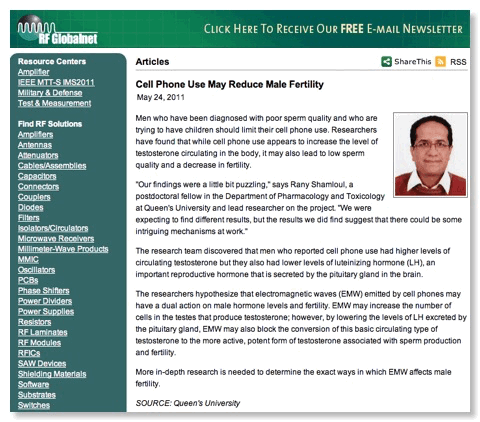
Note that this is not from some “tree hugging” environmental group or antitechnology group, but is the most popular story today on an advertiser-supported wireless “techie” website RF Globalnet.
New WHO Finding on Cellphones: Will CTIA Let FCC Take a More Proactive Stand?
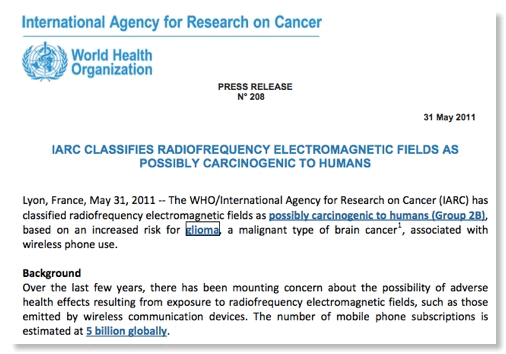
Today the World Health Organization’s International Agency for Research on Cancer (IARC) released the above statement on a possible connection between “wireless phone use” and cancer.
CTIA’s ever quotable John Walls responded,
“Today, an International Agency for Research on Cancer (IARC) working group in Lyon, France categorized radiofrequency fields from cellphones as ‘possibly’ carcinogenic based on ‘limited evidence.’ IARC conducts numerous reviews and in the past has given the same score to, for example, pickled vegetables and coffee. This IARC classification does not mean cellphones cause cancer. Under IARC rules, limited evidence from statistical studies can be found even though bias and other data flaws may be the basis for the results.“The IARC working group did not conduct any new research, but rather reviewed published studies. Based on previous assessments of the scientific evidence, the Federal Communications Commission has concluded that ‘[t]here’s no scientific evidence that proves that wireless phone usage can lead to cancer.’ The Food and Drug Administration has also stated that ‘[t]he weight of scientific evidence has not linked cellphones with any health problems.’”
CNN posted the following video on the issue:
Your blogger agrees with the tone of the CNN video. There is no need to “freak out”, but we should try to reduce exposure in reasonable ways. This is something that has been proposed here several times along with references to to the proactive stance of CTIA’s French counterpart.
Unfortunately, CTIA and its members are still stonewalling behind the viewpoint that since cellphones meet all present federal standards, nothing else is needed. Industry sources tell your blogger that this is based in part on trying to limit industry liability if health problems are later found. I hope the public finds that reassuring and is glad to know that FCC supports CTIA’s parochial interests in this matter.
Gupta: Cell phones, brain tumors and a wired earpiece -- CNN
On May 20, CNN posted the above video with an accompanying article where Dr. Sanjay Gupta talks about cell phones and brain cancer. Besides being CNN's chief medical correspondent, Dr. Gupta is an assistant professor of neurosurgery at Emory University School of Medicine and associate chief of the neurosurgery service at Grady Memorial Hospital in Atlanta, Georgia. In 2009, it was widely reported that he was offered the post of Surgeon General in the Obama Administration but turned it down.
In the face of repeated alarmist claim that cell phone use causes brain cancer, CTIA and the cellular industry responds with stonewalling that this is no proof and that cell phones meet all government standards - both literally true. Critics though focus on brain cancer although occasionally mentioning a large laundry list of other pathologies - all without any credible evidence. Why the focus on brain cancer as a possible impact of cell phone use? Probably scare tactics from the anticellular forces since brain cancer is one of the scariest diagnoses around and it thus helps grab headlines. Other possible pathologies just don’t get the same headlines.
Faced with this emotion loaded but evidence lacking threat, CTIA responds with legal stonewalling which industry sources says is focused on minimizing industry liability if same adverse health effect of cell phone use is ever proven. That may be a reasonable lawyer-driven response for industry in such a situation, but is it a reasonable approach for a regulator acting in “the public interest”?
While RF exposure to your head may not be doing you any harm, it certainly isn’t doing you any good. Thus while CTIA would prefer that the public just be given reassurances that everything is OK, presumably because “people trust government”. Well, the papers I read seem to indicate that many Americans do not trust government and FCC’s stonewalling on RF safety probably isn’t helping.
A better approach would be for FCC to clearly state that the best evidence shows the current standards are adequate but that individuals can take certain steps to decrease their exposure such as
- using Bluetooth-like earpieces,
- using phone preferentially in locations with stronger base station signal/“more bars”, and
- considering phone with lower SAR values. (Note this last issue is the one that FCC secretly flip-flopped on last year and has never publicly explained.)
The cellular industry’s long term legal liability should not be an issue here. If cell phones are really safe, then it doesn’t matter how any new public information acknowledges possible risk. Yes, such a public information change might impact the industry’s liability if a cause and effect relationship is ever proven, but in that case wouldn’t voluntary lower public exposure have been a government positive action?
So, CTIA feel free to play your silly games with San Francisco on public knowledge of SAR data, but FCC should decide that in the face of uncertainty the “public interest” is not necessarily defense of CTIA and its membership but in protecting the public.
CTIA, SF, & SAR: Round 2 - The Craziness Continues

Yesterday, CTIA opened Round 2 of its struggle with the elected government of San Francisco. A press release proudly announced
Today, CTIA-The Wireless Association® filed a lawsuit in the U.S. District Court Northern District of California San Francisco Division to block enforcement of the San Francisco “Cell Phone Right-to-Know” ordinance. The ordinance challenges the Federal Communication Commission’s (FCC) determination that all FCC-compliant wireless handsets are safe by mandating that retailers post Specific Absorption Rate (SAR) values. The ordinance misleads consumers by creating the false impression that the FCC’s standards are insufficient and that some phones are “safer” than others based on their radiofrequency (RF) emissions.
The CTIA complaint filed in federal district court is shown at left and linked to the image. In filing this complaint CTIA has engaged 4 different law firms:
Jones Day - “more than 2300 lawyers around the world”
DrinkerBiddle - “We lead complex and sophisticated business transactions and litigate many of the most important legal challenges that our clients face.”
Wiley Rein - “Broadcasting & Cable has recognized Wiley Rein as a ‘powerhouse law firm.’ “
Kirkland & Ellis - “A law firm serving global clients”
CTIA members:
How much is this costing you?
Is that why you don’t have money for buildout of new systems?
Since voice minutes are actually decreasing due to the growth of smartphones which are much more intensive users of your networks and for which SAR values are much lower, why does this really matter now?
The CTIA Complaint drafted by its 4 pricey law firms states that
“the Ordinance is expressly preempted by Section 332(c)(3)(A) of the Communications Act, which prohibits state-imposed conditions on “entry” to the wireless market, including point of sale ‘warning requirements’ and labeling requirements” (p.3, l.7-9)
A quick review of Section 332(c)(3)(A) finds no mention of “ ‘warning requirements’ and labeling requirements’”.
The complaint states in its opening paragraph:
The FCC has stated that any cell phone that complies with the (SAR) standard is safe, regardless of whether its SAR value is at or somewhat below the SAR limit” (p. 1, l. 27-28, emphasis in original)
Yet later on when it discussed this in depth the only reference it gives to FCC’s safety finding is a URL to the Commission’s Consumer & Governmental Affairs Bureau webpage, not to a finding by the Commission in a decision. The section they quote from that webpage is
The FCC requires cell phone manufacturers to ensure that their phones comply with these objective limits for safe exposure. Any cell phone at or below these SAR levels (that is, any phone legally sold in the U.S.) is a "safe" phone, as measured by these standards. The FCC limit for public exposure from cellular telephones is an SAR level of 1.6 watts per kilogram (1.6 W/kg).
I have trouble going from this FCC staff remark on a web page to the CTIA viewpoint stated about: “The FCC has stated that any cell phone that complies with the (SAR) standard is safe, regardless of whether its SAR value is at or somewhat below the SAR limit”.
CTIA’s ever quotable John Walls said in the press release “The problem with the San Francisco ordinance is not the disclosure of wireless phone SAR values – that information is already publicly available.” Yes now it publicly available, but no thanks to CTIA and its membership. Ten years ago they strongly fought Chairman Kennard on this issue when he sought to follow the UK in making the SAR data readily available to the public. They tried to keep the information as buried as possible within the FCC’s ever chaotic website.
But Mr. Walls, why aren’t you also suing or at
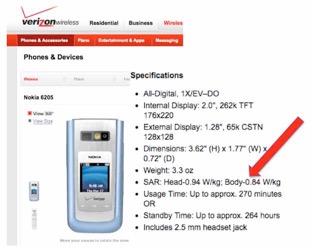
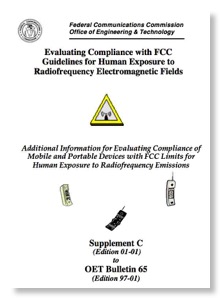
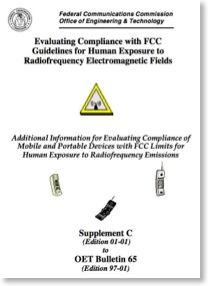

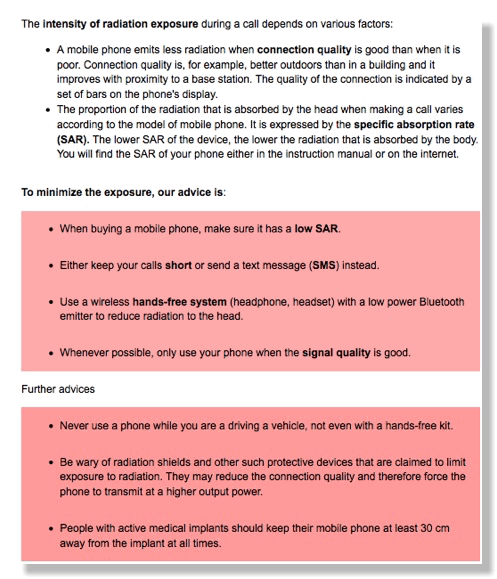
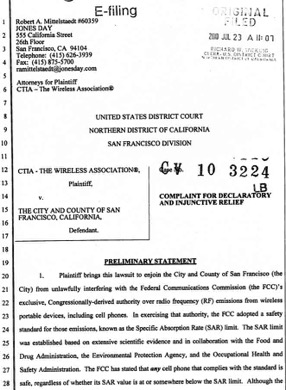



![Validate my RSS feed [Valid RSS]](valid-rss-rogers.png)

